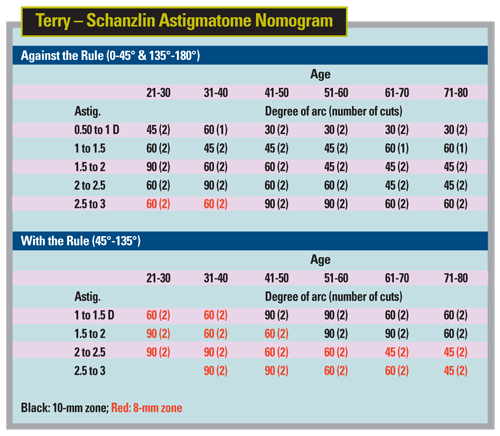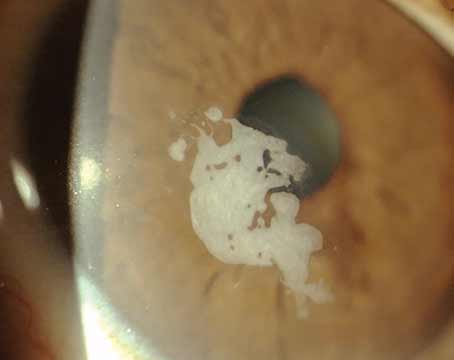If you're not familiar with performing a particular task, automating the job, such as using the macro function to execute several tasks on your computer, can save you time and make sure the task gets done properly with less chance for human error creeping in. Along these lines, the Terry-Schanzlin Astigmatome (Oasis Medical) is an attempt to take a maneuver that can be challenging for some—the creation of limbal-relaxing incisions or astigmatic keratotomy cuts—and standardize it to reduce the margin for error. Here's a look at how it works and tips from surgeons on how to get the most out of using it.
The Device
The Astigmatome is a device composed of three pieces that the surgeon assembles on the eye. The first is a vacuum speculum that builds suction via a disposable syringe similar to that used on the IntraLase laser. The device costs around $1,000, and the disposables add up to $60 per case.
The suction ring is centered on the eye, and as such dictates where the arcuate cuts will be made once the device is fully assembled and fixated. Onto the vacuum speculum goes a cutting template that dictates the length of the arcuate cut(s) in degrees of arc (30, 45, 60 or 90) and their optical zone, which can be 8 mm or 10 mm. The disposable blades fit into the template, and they are set for a particular depth of cut.
Once assembled and the blades enter the eye, the surgeon just turns the knob on top of the Astigmatome to make the cuts simultaneously (single cuts are possible, as well). Therein lies the advantage of the device, say proponents: the ability to make two curved incisions of the same optical zone, length and depth more reproducibly than a surgeon could if he did each cut separately by hand. "Sometimes, with freehand incisions, you find that the LRIs you performed weren't enough to achieve the results, which is a problem if you implanted a multifocal intraocular lens," says Luis Torres, MD, PhD, of
Dr. Torres acknowledges, though, that some surgeons, mainly the ones with experience with freehand cuts, wouldn't really be in the market for the device, but adds that it's probably a boon to the newcomer. "I think it's a great tool for the younger surgeon, like myself," he says. "We aren't used to doing freehand AK, and haven't been trained for those types of incisions. But now, with multifocal lenses, we have to learn those incisions to ensure the best vision postop. With the Astigmatome, everyone can do them."
Minneapolis
There are some potential drawbacks, though. For one, as Dr. Hardten mentioned, the cut is a blind movement, since the view of the cut(s) is blocked by the Astigmatome itself. The surgeon has to have faith that he set all the cutting parameters correctly.
"With any incision technique, even a diamond-knife incision, the guard that keeps the knife from going too deeply occludes the view," asserts
Dr. Schanzlin says there currently isn't data on the use of the Astigmatome, but he says that any complication with the device always filters back to him or the device's original developer Clifford Terry, MD, through Oasis. "We hear about a surgeon making the cut in the wrong direction about twice a year," he says. He also estimates that it leans toward undercorrection, if anything, because surgeons may not push sufficiently hard on it until they get comfortable with using it.

Using the Astigmatome
Most of the work with the Astigmatome occurs in setting it up for the cut. As was alluded to by Dr. Schanzlin, after consulting the nomogram (above) to determine the number of incisions, their length and optical zone, the surgeon sets the blades to 95 percent of the corneal pachymetry in the area of the incisions. As for optical zones, as one might imagine, the 10-mm zone has less of an effect, but is more forgiving, and vice versa for the 8-mm zone.
To find the proper area to cut, Dr. Schanzlin recommends cutting right on the inflection point of the astigmatism, or the point at which the sudden change between steep and flat cornea occurs. "To find the inflection point, look for the color shift on topography, where it goes from red to blue," he explains. For penetrating keratoplasty patients who have astigmatism postop, Dr. Schanzlin says the idea of "cutting in the red" on topography is really the only way to approach them. "With PK astigmatism, I use a 6-mm zone at 90 percent depth and make the cut the length of the arc defined by the hourglass [on topography]," he says. "That turns out to be almost identical to the inflection point." He says the PK patient illustrates an instance where it's probably best for the surgeon to just look at the topography and cut in the red, because the asymmetry of the cut on one side vs. the other may actually be necessary to properly treat a PK patient.
In some cases, instead of making two incisions, the surgeon can make one and use his cataract wound as the other to treat some astigmatism. "I sometimes combine one clear-corneal cataract incision on-axis with one LRI 180 degrees away," says Dr. Torres. "How effective I am with this approach depends on the amount of astigmatism the patient has. If the patient has 1.5 D, the clear-corneal incision will maybe take care of 0.5 D, and the other cut will take care of the rest. It's usually for smaller amounts." For his cataract wound, he makes a 3.2-mm clear-corneal incision.
The limit that the Astigmatome can correct is around 3.5 D. "I usually use the 10-mm zone for less than 2.5 D," says Dr. Torres. "If a patient has 2.5 to 3.5 D, I'd use the 8 mm. If there's more, I try to use another kind of surgery, maybe excimer or a toric IOL combined with LRIs or AK. Usually, though, the ReSTOR patients I operate on have less than 2 D, and I can do those cases with the 10-mm zone."




